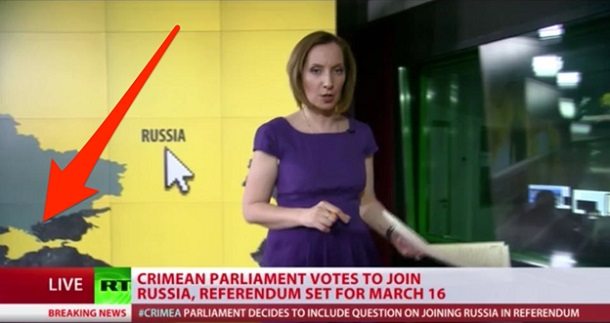
March 11, 2014;Devex
Obviously, the U.S. can only do so much regarding intervention in Ukraine, but the situation in this country on the border of Russia is neither unprecedented nor inconsequential. Vladimir Putin’s military aid to help ethnic Russians split the Crimean peninsula away from Ukraine—as shown below, the Russian English-language news network RT is already showing Crimea as part of Russia—is similar to the strategy used against Georgia, supporting Russian nationalist secession elements in Abkhazia and South Ossetia and against Azerbaijan with a similar strategy in the area of Nagorno-Karabakh. (Note: Yesterday, the Crimean parliament voted itself independent ahead of a referendum scheduled for next week on whether it should secede from Ukraine, declaring the creation of the “Autonomous Republic of Crimea.”)

Sign up for our free newsletters
Subscribe to NPQ's newsletters to have our top stories delivered directly to your inbox.
By signing up, you agree to our privacy policy and terms of use, and to receive messages from NPQ and our partners.
Other countries bordering Russia are apprehensive, notably the Baltic nations, where there are also large Russian ethnic minorities, some due to their long occupation by Stalin’s USSR. Last week, the Russian ambassador to Latvia proposed making it easier for ethnic Russians in that country to obtain Russian citizenship (Russia already hands out Russian passports to them) in order to “save the Latvian noncitizens out of poverty by giving them citizenship and a pension without having to stay in Russia.”
Devex’s Jones sees the EU offer of €11 billion (roughly $15 billion) in economic and development assistance for Ukraine as important to “stabilize Ukraine’s faltering economy and aid the country’s interim government.” The Obama administration followed the EU decision with a $1 billion aid package, notable since USAID’s 20 year history of aid to Ukraine has been only $1.8 billion and total U.S. aid to Ukraine from all federal agencies has run in the range of $100-200 million per year from fiscal year 2006 to 2013 (planned, not necessarily obligated or spent); in comparison, over a 20 year period since 1991, the EU provided Ukraine with €3.3 billion in grants and €10.5 billion in loans. The new $1 billion from the U.S., however, is loan guarantees, presumably for the National Bank of Ukraine, “aimed at helping insulate vulnerable Ukrainians from the effects of reduced energy subsidies.” That’s a probable reference to Russian subsidies for gas, a tactic that Russia has also used before. The EU assistance, unlike the U.S. package, is a mix of loans and grants:
- €3 billion in economic assistance, including €1.6 billion in “macro-financial assistance loans” (apparently €610 million of which can be quickly put into action) and €1.4 billion in development assistance grants spread over seven years
- €8 billion from the European Investment Bank and the European Bank for Reconstruction and Development.
- €3.5 billion leveraged through the EU’s Neighborhood Investment Facility.
Both the EU and the U.S. have also pledged to provide technical assistance for democratic reform in Ukraine—in the words of the White House, “technical assistance to train election observers, help bring electoral processes in line with international standards, and promote robust participation by civil society organizations and a free and independent media.”
Economic development, humanitarian assistance, energy subsidies, and more will all probably be appreciated by the Ukrainian people. What may be most at risk in the wake of the violence unleashed by the Yanukovych government against the protesters in the Maidan, the invasion of tens of thousands of Russian troops in Crimea, and the difficulties that will emerge if military action increases is the future of Ukrainian civil society. Governments and philanthropists are facing a fluid, unpredictable situation in Ukraine, making it hard to pinpoint what they should do. Some pertinent questions for government and private donors might be these:
- Do they know enough about what is happening in the Ukrainian civil society space in order to make intelligent diagnoses of how the distribution of aid might help with the stabilization of the country? As much as the intervention of Putin might be completely objectionable, aid donors do not want to find themselves in the unfortunate position of seeing their funds go to ultra-nationalist extremists of any sort.
- Do the NGOs that they might choose to work with have a strong relationship and commitment to building Ukrainian civil society as opposed to simply being conduits for externally controlled and directed aid? If the dynamic of cooperation and collaboration between non-Ukrainian NGOs and Ukrainian organizations is thin, the result won’t be one of strengthening indigenous civil society.
- Are there mechanisms of coordination among the various NGOs, including among NGOs that have different emphases, for example, those that are focused on economic development and others than have “democracy-building” as their primary objectives? The chaos among aid providers in other countries has been a serious issue.
- Finally, are there mechanisms for transparency in the purposes, uses, and recipients of aid? It is difficult enough to wade through the obfuscation of U.S. aid categories and discover, even for Ukraine, how much of past aid has been focused on military, security, and policing issues and how relatively little has been for humanitarian and educational purposes. If U.S. aid from the government and from philanthropists lacks a modicum of transparency—above and beyond that required by the law—the publics in both Ukraine and the U.S. will be suspicious about who really benefits. Given Viktor Yanukovych’s pride in his governmental corruption, his predecessor Yulia Timoshenko’s history of unproven and proven charges of corruption, and Ukraine’s embarrassing overall corruption ranking according to Transparency International, aid donors cannot and should not allow themselves to play into a continuation of Ukraine’s problems in this sphere.
There is no easy algorithm for figuring out how governments, foundations, and individual donors might send aid to Ukraine.—Rick Cohen













